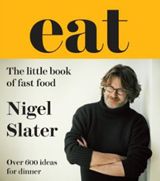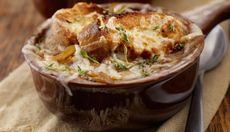The very best cookbooks
The latest crop of cookbooks include some gems from Nigel Slater and Simon Hopkinson


Each Christmas, hors d'oeuvres of recipe books have publishers trying to do something really, really different. From this, you can tell where cookery fashions are going. Apart from a tasting menu of pretentious chef-driven ones costing more than the week's groceries (who buys them, I wonder?), most of this batch concentrate on simplicity. There also seem to be fewer obnoxious television chefs, praise the Lord.
Eat Nigel Slater (Fourth Estate; £26 *£20) Nigel Slater specialises in ground-breaking recipe books and this is no exception. First, he sees that most of us cook for ourselves virtually every day. Parties are rare events. Second, as he says, ‘cookery should be a light-hearted, spirited affair, alive with... a sense of adventure'. Third, he simplifies recipes ‘in the style of an extended tweet'. Fourth, he adds variations for the recipes. Fifth, he's realistic enough to use supermarket chicken stock, puff pastry and mayo. As usual, every recipe is clearly written by someone who loves his food. Photographs play a secondary part, but I loved the dirty oven gloves and pie dish. There are more than 600 recipe suggestions here (compare and contrast with Le Livre Blanc's 50.)
Simon Hopkinson Cooks (Ebury Press; £25 *£20) I know I will use this a lot. Simon Hopkinson is a wonderfully uncheffy chef and, in this book, published to tie in with his latest television series, he does real meals: a Sunday roast, a cosy supper. Not only are his dishes classics-roast lamb, sherry trifle and potted shrimps-but each menu is prefaced with a cocktail. Totally unpretentious-a rarity.
Fast Cooking James Martin (Quadrille; £20 *£16) James Martin gives himself 20 minutes to create each dish, but, as a result, you need to spend more time on finding ingredients. He uses exotic extras to create a difference and, mostly, it works. Good for busy cooks who live near a well-stocked supermarket or Chinatown for that essential ponzu juice.
Mary Berry's Cookery Course (Dorling Kindersley; £25 *£20) I mustn't let the horrid pastel cover put me off. This is actually very helpful stuff, complete with Dorling Kindersley's signature working photographs and unchallenging dishes. Ideal for young enthusiasts, the recipes are clear and straightforward to follow.
The Great British Vegetable Cookbook Sybil Kapoor (National Trust; £25 *£20) Simple dishes with flair, such as sticky blackcurrant shallots (using cassis), broccoli with tahini and orange-cooked endive. Good for kitchen gardeners growing sorrel and nettles. Charming photographs of National Trust properties.
The Modern Art Cookbook Mary Ann Caws (Reaktion; £25 *£22.50) A curious idea, but then artists painted food as often as themselves. The author has previously written on Picasso, Mother-well and Dalí and here combines artists' paintings with their recipes. Try Cézanne's pears and quinces with honey or Roy Lichtenstein's roast fillet of beef. Less a kitchen book than a feast for the eyes. No index, which is crazy.
Sign up for the Country Life Newsletter
Exquisite houses, the beauty of Nature, and how to get the most from your life, straight to your inbox.
The Gentle Art of Preserving Katie and Giancarlo Caldesi (Kyle; £25 *£19.95) Very much a hot topic, but it's not all jam and chutney. You learn how to infuse herb vinegars and where to use them, how to brine lemons, cure gravad lax or dry fruit and mushrooms. Both inspir- ing and surprisingly useful.
Five Fat Hens Tim Halket (Grub Street; £12.99 *£11.69) A diary of a hen keeper who loves his birds (and who won't eat Basil the Welsummer cockerel)-I know the feeling. I love this book: totally unaffected, real recipes you want to cook. ‘I sincerely hope you will keep this book-food splattered and grease stained-in the kitchen,' Mr Halket writes. I will and you should, too. One: a cook and her cupboard
* Give Country Life for Christmas and save up to 40% on a subscription
Florence Knight (Saltyard Books; £26 *£20) The chapters are divided into basic ingredients such as olive oil, ketchup, nuts and honey, with a useful intro on each. Miss Knight, at 27, is currently head chef at Polpetto and this is her personal, modern take on international favourites.
The Ethicurean Cookbook Jack Adair-Bevan, Paûla Zarate, Matthew and Iain Pennington (Ebury Press; £25 *£18.95) These four friends have a walled garden in Somerset (‘an absolute paradise') with a restaurant that uses their own and local produce. As the name suggests, they do their best to be both Green and gorgeous. The recipes are delightful-frozen local cider with Keen's Cheddar flake, pickled nasturtium seeds and salt-marsh lamb with tidal greens. Inspiring for all those living in the country, especially with walled gardens. The photographs and design are ravishing.
Great Homemade Soups Paul Gayler (Jacqui Small; £25 *£18.95) I make soups when time is short and a solid meal is needed, so Mr Gayler's book hits home. I also like single-subject books.
Leiths How to Cook Claire Macdonald and Jenny Stringer (Quadrille; £30 *£27) As Yotam Ottolenghi says on the cover, this massive compendium is crystal clear and super instructive-for example, the sweetcorn-soup recipe (which I cooked last week) was perfect, although I didn't blitz the results. A whopping 671 pages.
A Love for Food Daylesford with Sheila Keating (4th Estate; £30 *£25) Smug and goody-goody about seasons, sustainability and soil, but full of updated British food with helpful advice about which variety of vegetables to grow.
Le Livre Blanc Anne-Sophie Pic (Jacqui Small; £45 *£35) And here's one for those who never cook-Le Livre Blanc is quite the most pretentious cookbook I've seen. A white cover and superfluous slipcase are ridiculous in the kitchen, the main typeface is near illegible and the food photographs are totally separated from the recipes. Despite the price and 225 pages, there are only 50 recipes.
Finally, a few general complaints: please could designers put page numbers at the bottom of each page, rather than at the side or top. Usefulness is more important than looks in a recipe book. And it would be helpful if indices were to reveal more than the name of the dish-cooks may want to know a dozen different ways to incorporate say, asparagus, in a meal. The Slater index is a model of its kind; but, sadly, the page numbers are not.
Bringing the quintessential English rural idle to life via interiors, food and drink, property and more Country Life’s travel content offers a window into the stunning scenery, imposing stately homes and quaint villages which make the UK’s countryside some of the most visited in the world.
-
 The real name of a 'ghost' rainbow, the first ever omnishambles, and golf on the moon: Country Life Quiz of the Day 20 February 2025
The real name of a 'ghost' rainbow, the first ever omnishambles, and golf on the moon: Country Life Quiz of the Day 20 February 2025Some real brainteasers for you in our Quiz of the Day. Good luck!
By Toby Keel Published
-
 Tom Parker Bowles's favourite recipe: French onion soup
Tom Parker Bowles's favourite recipe: French onion soupThis dish is no mere Gallic broth, rather pure bonhomie in a bowl — a boozy, beefy, allium-scented masterpiece that cries out for the chill depths of winter
By Tom Parker Bowles Published